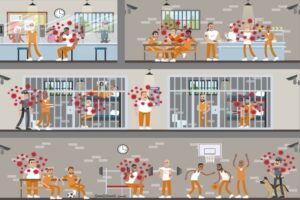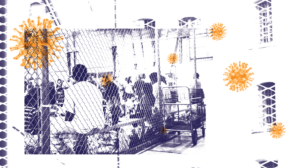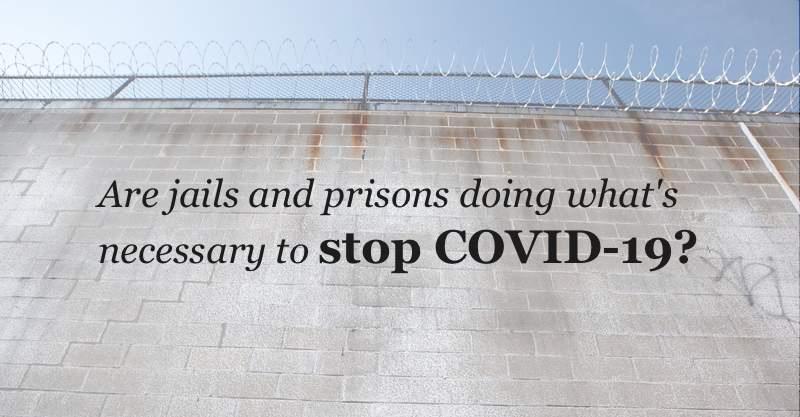“The degree of civilization in a society can be judged by entering its prisons.”
—Fyodor Dostoyevsky, The House of the Dead
Note: Please be advised that as things are changing quickly during this pandemic, the information available on the conditions inside will continue grow exponentially. It is and has been increasingly difficult to keep up with the developments and information. Nevertheless, the message is clear: thousands of lives are at risk. This brief commentary on the great risk looming over our correctional facilities urges the need to act immediately and transparently to ensure the safety of one of our most vulnerable populations.
Correctional Health is Public Health

Credit: Jim Vondruska/Reuters
“We MaPrisoners pleading for help in a window of the Cook County jail on Tuesday.
As of April 7th, Chicago’s Cook County Facility has become the top hotspot for the virus in the U.S. According to data compiled by The New York Times, the jail in Chicago is now the nation’s largest-known source of coronavirus infections. Why is this a problem? More importantly, why should we care about what occurs inside these institutions? The short answer to these questions is this: correctional health is public health.
What happens inside will inevitably influence what happens outside. Any outbreak within our jails and prisons can cascade into the community. Once COVID-19 spreads throughout a facility, the burden of caring for these sick individuals will necessarily shift to local community medical facilities. Large numbers of seriously ill incarcerated individuals would strain the already taxed hospitals, increasing the morbidity and mortality of all people in NY.
Correctional Facilities Create Optimal Conditions for an Infectious Disease Outbreak
After spending seven years in New York’s jails and prisons, I am all too aware that the inadequate healthcare and hygiene in correctional facilities create optimal conditions for an infectious disease outbreak. During my time at Bedford Hills and Taconic, waiting days or weeks to have my sick-call slip addressed by a doctor was nothing out of the ordinary. I would first have to see a nurse who would determine whether I needed to see a doctor another week from then. Access to cleaning supplies were limited, leaving us to rely on our peers to acquire larger quantities of stolen bleach from our fellow inmates due. With these dynamics at play, should any be surprised to learn that many inmates are currently self-manufacturing sanitizer to clean phones with diluted soap and shampoo that may afford them little to no protection against the virus? Sanitizers remain inaccessible to most inmates due to its high alcohol content. To what extent can inmates stay healthy and keep their living quarters clean under such conditions during this pandemic if it is hard to do so under normal conditions?
Spread of the Novel Coronavirus is Now Accelerating within Our Jails and Prisons
This post follows the first reported death of an in inmate in NYC (NY Times). As of April 8th, “more than 700 people have tested positive for coronavirus on Rikers Island, including over 440 staff.” At least seven correction officers have died as well. Across NYS, at least two inmates, two parolees and a civilian have died. At least 55 inmates have contracted the virus.

Photo Credit: Buzzfeed News
Michael Tyson, 53, was the first person to die from COVID-19 complications at Rikers Island Jail. He was being held fora technical parole violation—not a new crime. Governor Cuomo is receiving heat for failing to release a biologically vulnerable individual whose release posed to society.
Will these numbers finally forces us to pick up pace in releasing more inmates? The spread of the novel coronavirus is now accelerating within our jails and prisons across the nation. In fact, as of April 7th, the infection rate inside Rikers Island was reported to have been at 6.59%, considerably higher than the infection rate of New York City, .89%. As expected in confined spaces, rapid spread of the virus is much more pronounced for inside the jail than outside.
The number of individuals testing positive for coronavirus has surged in the past two weeks but New York’s strategy for battling a potentially disastrous outbreak within our jails and prisons has lagged far behind. In fact, a New York judge has only very recently mandated all correction officers to receive nonsurgical masks and rapid COVID-19 tests before every shift. This decision came on the heels of a lawsuit filed against the city by the Correction Officers’ Benevolent Association. Considering that it is far less likely that an inmate would bring coronavirus into a facility than would the daily ingress and egress of staff, this delay to protect inmates is rather disturbing.
Despite the vulnerability of this population, news coverage on jail and prison conditions remain minimal.

Source: CNN
New York Governor, Andrew Cuomo, announced a new hand sanitizer developed by the state after widespread shortages caused by the novel coronavirus outbreak. The sanitizer is developed by Corcraft, which uses low-cost labor from inmates.
In fact, one of the first lengthy dialogues on COVID-19 and NY’s inmates was entirely devoted to quelling public panic about a statewide shortage of sanitizer. On March 9th, Governor Cuomo readily announced that NYS inmates were mass producing sanitizer for the state as a response to this shortage. Needless to say, his attempt to comfort the public was devoid of any reassurances about our inmates’ health. There was comparable silence on the details of the protective measures for inmates as we learned that inmates at Rikers Island were being offered $6.00 an hour and PPE to dig mass graves on Hart Island.
Transparency Breeds Trust
Now, it should seem that at a time of panic, pressure, and uncertainty, receiving more transparency from our leaders would be common sense. We need to know more than just how our loved ones inside are being exploited to meet the needs of the pandemic. Visitation bans across all facilities within NY makes it more pressing necessary for the news to keep us updates and informed about preventive and mitigating measures being taken inside. The following are some of the questions that need addressing.

Source: https://theintercept.com/
While detailed reports by elected officials about protective measures in corrections have been few and far between, “Prisoners may be safer in the fresh air of Hart Island, digging mass graves while wearing PPE” appears to be the comfort we’re offered regarding inmates’ safety.
- How is social distancing being promoted in crowded housing units?
- What measures have been taken to strike a balance between protecting inmate health and rights?
- How many inmates are being tested?
- What will happen in the event that medical staff or correctional staff fall ill to the virus and have to quarantine?
- How will that shortage be addressed?
- How are the medical needs of those who were sick in long term care prior to the pandemic having their needs met?
- Are inmates being given access to sanitizer, soap, and bleach?
- How are inmates that have to regularly leave their facilities to receive medical care at hospitals or other facilities being accommodated medically?
- To contain the spread of the disease, infection prevention protocols must be meticulously followed. Even if people are being quarantined in these facilities, to what extent can the CDC’s guidelines for detention facilities be observed when inmates have to line up for medication and share showers, cooking and dining spaces, toilets, and dorms?
Naturally, questions about the public safety implications of a large scale release of inmates have also surfaced. Questions about whether those released will commit crimes are valid; however, they are not the most pressing at the moment.

Source: https://www.medpagetoday.com/blogs/doing-time/85366
Should We Let High-risk Inmates Die?
At Rikers Island, a woman named Elisa expresses her concerns, illuminating the life-or-death situation inmates are facing behind bars. According to The New York Daily News, Elisa was required to strip the bed of an inmate who had tested positive for the novel coronavirus. Elisa, who has AIDS, was required to do so without gloves or mask, despite her immunocompromised status. Furthermore, her lawyer’s request for her release and a slew of other secure alternate release were denied by the Manhattan District Attorney’s. Despite her low security risk and preexisting conditions, the Manhattan District Attorney’s office argued that it could not consent to her bail because she was already sentenced to state prison time. Like Elisa, scores of high-risk inmates are confronting the reality that they may die in prison.
Social Distancing Nearly Impossible in Correctional Facilities
At the same time. releasing only those at risk of complications from the novel coronavirus will only have a minor effect on spread of the illness in the close quarters of jails and prisons. All inmates remain vulnerable by virtue of their environment.

Source: Mercury News
In fact, even for those who are low risk for severe illness, there is substantial difficulty to adhere to the Center for Disease Control’s recommendations to prevent the spread of the virus. While releasing more inmates certainly reduces the density within these environments and may consequently slow the spread of the virus, social distancing is nearly impossible within these facilities.
The dynamics at Bedford Hills Correctional Facility at this very moment underscore this reality. In the spirit of quarantining and self-distancing, the facility has limited movement by canceling all programs and interactions between different housing units. Still, dozens of women are still gathered around each other on their housing units’ phone, cooking, and recreational areas daily. Dormitory areas fare even worse where as many as 60 inmates sleep together in close quarters. For these women, only thin bed frames and partitions separate them from their bunkmates and neighbors. Rest assured, the idea of consistently maintaining a 6 feet distance is next to impossible in these spaces.

Source: https://action.aclu.org/
To the previously posed question, “should we let inmates die?” I pose another: “what gives us the right to ask that question?”
The Eighth Amendment of the U.S. Constitution requires that “inmates be furnished with . . . reasonable safety,” and the Supreme Court has explicitly recognized that the risk of contracting “serious contagious diseases” may constitute such an “unsafe, life-threatening condition” that it threatens “reasonable safety.” Thus, we have a constitutional failure looming over us if we continue to take a slow, business-as-usual approach to releasing inmates immediately.
Regardless of what a person may have been accused or convicted of, no individuals deserve to be placed at higher risk of a life threatening illness when reasonable preventive measures are available.



Thank you for this. Such an important article <3
I love this piece- it’s so urgently needed, and it is so good: ‘To the previously posed question, ‘should we let inmates die?’ I pose another: ‘what gives us the right to ask that question?'”
Thank you for calling out and rewriting the narrative of who deserves community and care, of who’s considered vulnerable.
I am wiser and sadder for reading your article. Thank you for your reporting on New York’s vulnerable and neglected prison population.
This is a very interesting article. Please, share more like this!